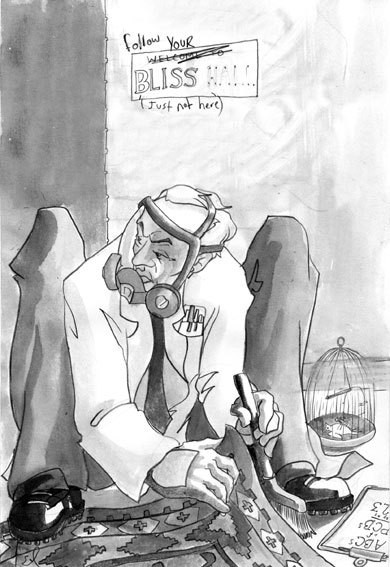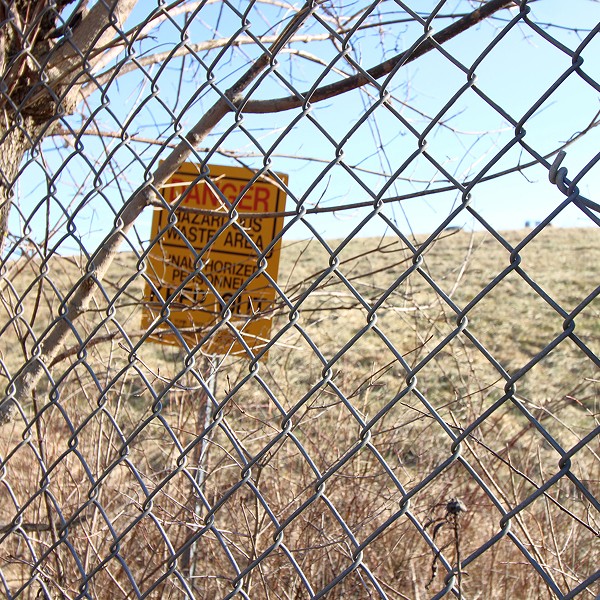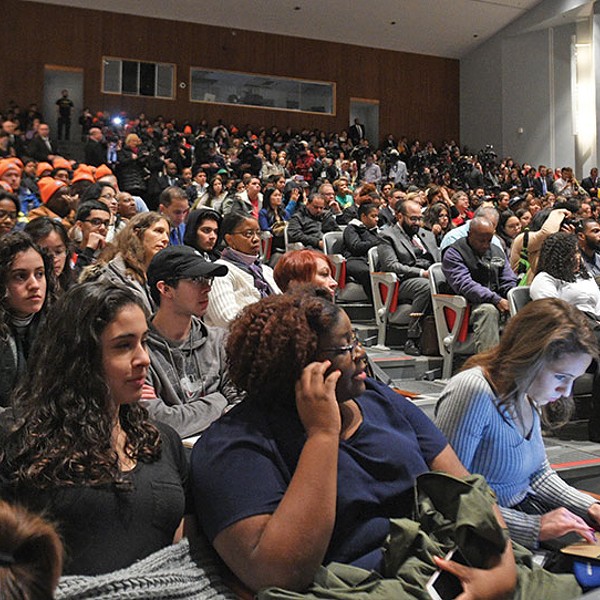If Gage Residence Hall at suny New Paltz were a chemical waste facility, the pcb levels in its exhaust vents would exceed Environmental Protection Agency safety standards by up to eight-fold. Federal law says 10 parts per million is the limit in a vent; the Gage Hall vent tested at 80 parts. This contamination exists not in a remote corner of the building, isolated from residents, but rather in dust above a stove in a student lounge. Vents connect every lounge, laundry room, bathroom, and shower stall in the building.
Gravel in the Gage Hall basement contains nearly three times the federal limit for outdoor soil—at an industrial facility, mind you, not a residential one. There are no federal limits for homes because there are not supposed to be any noticeable concentrations of pcbs where people live. Since February 1992, 370 students have lived inside the building.
There is also contamination in a dusty radiator in the building’s back entrance way. A ceiling tile in a student lounge, above a television set, is laced with pcbs. So is wallpaper in the same room; the room is open and unlocked, not sealed in plastic. There are no warning signs anywhere. Except for rumors, most students are clueless.
This building is certified clean, and was part of a $50 million cleanup effort. But Gage Hall and neighboring Capen Residence Hall were opened long before most of that money was spent.
A few paces across campus, in Capen Residence Hall, a dusty, lint-filled vent in the laundry room has more than double the federal allowable pcb level for a factory or chemical waste facility—23 parts per million. A radiator matted with dust, thick as carpet padding, has high levels of contamination, which raises the frightening prospect that every radiator in the building is contaminated. Electrical wires, wiped down with alcohol and a swath of cotton, showed high levels of contamination, raising the prospect that electrical outlets in the building are contaminated.
How do I know this? Early on the morning of February 12, 2004, I entered Capen and Gage halls with two student witnesses and collected the samples myself. Later that morning, I sent seven sample jars to a first-rate private laboratory in California, Sequoia Analytical, whose clients include private industry as well as municipal, state, and federal agencies. (My publishing company, Planet Waves, Inc., paid for analysis of the samples.)
This is called independent citizen sampling, and I did it because suny’s published reports of the levels seem unusually low, given that in December of 1991 pcb transformers burned in both Capen and Gage. Having investigated and written about the botched PCB cleanups in these dormitories since 1992 (including many articles for Chronogram, the New Paltz Times, and the Woodstock Times), I wanted to know the truth, and I did not want to hear it from someone else.
The results are in: All seven samples show pcbs, some at extremely high levels.
For years—in fact, since the very days Capen and Gage halls opened a month after the explosions—everyone has been told that these buildings are perfectly safe. Parents had their doubts on those freezing February mornings when the structures were reopened before the test result books were available for examination, and when cleanup workers in Tyvec suits and respirators still roamed the campus.
But were those test result books, which you can still find in the campus library, at all meaningful? Capen and Gage were re-opened without any tests having been run on the ventilation systems. Heating systems in Capen, Gage, and Scudder were also ignored, despite the fact that the Bliss Hall heating system was discovered to have been a path of contamination in 1992. Now, it seems, we can see why no heat and vent tests were taken in Capen and Gage before the buildings were declared safe. The same is true of the Scudder Hall heating system. These systems were not declared safe on the basis of scientific data, but rather on the lack of it. Thousands of tests were taken on the campus, but these critical areas were ignored even when there were repeatedly discovered reasons to check.
It’s a mean trick. Under the best circumstances, the state usually acknowledges that pcbs have been left behind at “acceptable” levels in the buildings. (In a recent interview with the Oracle, suny New Paltz’s student paper, the campus housing director refused to acknowledge this.) My own tests show that contamination is a lot more pervasive. Even the epa, not known for its stringency, acknowledges that any level of exposure to these chemicals can pose a significant threat to human health and the environment. More exposure is worse. It’s widely acknowledged that these chemicals can cause multigenerational cancers, wreak hormone chaos, create birth defects, and grind down the immune system. And where there are degraded and burned pcbs, there are also dioxins, which are far more concentrated supertoxins and were in fact found in Bliss, Gage, and Scudder halls.
As recently as last month, the college administration was making blanket assurances of the safety of the dorms, in print, in the Oracle. “There is no reason for alarm on this campus, as we have been held to extremely high standards of safety from pcbs,” Arnold Bernardini, a vice president of the college, wrote to students and staff in an op-ed piece.
You may be wondering what the State of New York had to say about my early-morning sampling expedition and the results I got from the lab. I met with two campus officials to go over the results face-to-face on the afternoon of March 3. Everyone taped the meeting. The prior Friday, I had sent my test results to the college’s new president, Steven Poskanzer. He, in turn, sent them to various state officials for their review.
I sat at the table with Bernardini, the vice president for facilities, and Eric Gullickson, a spokesman for the campus president. I carefully and methodically explained how and where I took my samples. Bernardini, who has been involved with the cleanup for a long time and is apparently the local administrative heir to the mess, showed some curiosity, asking for details about my sampling process.
It was Gullickson who laid out the college’s official position. Hesitating and nervous, Gullickson stumbled through a couple of aborted sentences before declaring: “You’re telling us that you found these results, but we don’t recognize the process that you went through.”
Thus spake the official spokesman for the campus, after searching for the right words: “We don’t recognize the process that you went through.”
I don’t blame him for being nervous. I would be nervous, too, if my job called for killing people I was supposed to be protecting. Now that these results are in the state’s files, suny officials are on notice that they have a previously unacknowledged pcb problem in their dormitories—but it’s one that they had a lot of reason to suspect was there. With that notice, a jury can find that they intentionally subjected the students to danger and harm; this is not a case of mere negligence.
As for my “process”? The state’s policy on sampling and analysis, he said, was laid out to him by somebody named Ed Horn in the New York State Department of Health. Horn, who saw the results of my sampling. “New York State requires that laboratories analyzing the samples from New York State must have appropriate certification by the New York State Environmental Laboratory Accreditation Program,” Gullickson said. “And that’s his interpretation of the results and the process that you went through to gather the results.”
In other words, the state’s position is not that the pcbs I found in the dormitories are not there. Nobody has said that. Instead, the college and the health department are saying that based on a technicality, they don’t count. Thus, they can ignore my results. State officials are also saying that I’m not certified to collect dust samples and put them in a jar.
I explained, in response, that 10 years ago I went into the same Gage Hall lounge and found high levels of pcbs. I took the samples myself; granted, the lab had the necessary state certificate, from New York. After vehemently denying that my results were meaningful, the health department ordered testing of the entire ventilation system, and discovered that the problem spread throughout the entire building. Then, the vents were cleaned to “arm’s length,” supposedly removing contamination from some of the horizontal portions, but leaving it in the vertical ones.
The results in the Gage vent are especially troubling because that’s one of the vents that was cleaned to arm’s length. And the pcbs that returned to 80 percent of their original level in just 10 years came from somewhere: from dust drawn into the vent, or from deeper in the uncleaned portion of the vent.
“It’s denial, of course,” says Dr. David Carpenter, Director of the Institute for Health and the Environment at the University at Albany, whose work on pcbs is known around the world. “That’s standard operating procedure for places that have this kind of contamination. You either discredit the analysis or you discredit the sampling method. Or you just discredit individuals.”
And where is the concern for human life? “That’s something that’s sadly lacking in our society. We see that again and again. With something that’s expensive to fix, that’s otherwise very dangerous, expense becomes the overriding consideration,” he explained.
“And of course, it’s easiest when the dangers are long term, not in the short term, you know, the cancers occur 30 years later. So that’s something that certainly I’ve been banging up against in lots of these studies, because while people at least sometimes acknowledge that there are dangers, the fact that it’s not an acute danger is something that lets people ignore it,” he said.
It’s worth not ignoring. “I think what you can say there without any question is that this is a reflection of extremely high levels of pcbs in the air in the building sometime in the past. Without getting air levels in the buildings, it’s not really possible to say there still is an ongoing exposure for people inside the building. I bet there is, but I don’t think you can say that if the measures were made in the out-vents. It certainly documents very significant exposure in the past. That presumably was all particulate,” that is, in dust.
“It’s indicative of the magnitude of the exposure at least at some time in the past, and it’s at least suggestive that there’s ongoing exposure. But you can’t prove that,” he said, without additional testing.
As for the heating system, he said, “It sounds like there’s pcb deposit on the surface of radiators, which is not too surprising; if they haven’t been cleaned and if you have that level in the air ducts.”
For many years, Carpenter was Dean of the School of Public Health at the University at Albany. At the end of our conversation, I asked him about the lab that I used. He said, “There’s no problem whatsoever.”
























